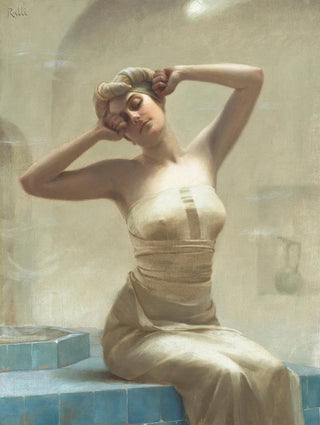Art print | In the bath - Theodoros Ralli


View from behind

Frame (optional)
Theodoros Ralli – Captivating Introduction
Amidst the tumult of artistic movements that marked the late 19th century, the art print "Au bain" by Theodoros Ralli emerges as an ode to beauty and the intimacy of everyday life. This painting, imbued with a delicate atmosphere, transports us to a universe where time seems suspended, inviting the viewer to contemplate the simplicity of a shared moment. The artist, through his mastery of colors and shapes, manages to capture not only a scene but also an emotion, a sense of serenity that resonates with each of us. The soft light enveloping the female figures evokes human warmth, making the work all the more immersive and touching.
Style and uniqueness of the work
The art print "Au bain" stands out for its unique style, which combines realism and impressionism. Ralli, a virtuoso of color, skillfully plays with nuances to create reflections and shadows that bring his characters to life. The graceful curves of the female figures, bathed in golden light, are both sensual and soothing. Every detail, from delicate drapery to serene expressions, demonstrates meticulous attention to the representation of femininity. The artist does not limit himself to a simple visual depiction; he invites the viewer to immerse themselves in the intimacy of the scene, to feel the softness of the water and the warmth of the surrounding air. This ability to evoke sensations through painting makes "Au bain" an essential work that transcends time.
The artist and his influence
Theodoros Ralli, a Greek-born painter, managed to establish himself on the European art scene thanks to his undeniable talent and his unique vision. Trained in the major artistic centers of his time, he was influenced by contemporary currents while developing a personal style that is his own. Ralli captured the essence of everyday life, highlighting often overlooked scenes. His work reflects a particular sensitivity to the beauty of the world around him, as well as a deep understanding of human emotions. By incorporating elements of Mediterranean culture into his compositions

Matte finish

View from behind

Frame (optional)
Theodoros Ralli – Captivating Introduction
Amidst the tumult of artistic movements that marked the late 19th century, the art print "Au bain" by Theodoros Ralli emerges as an ode to beauty and the intimacy of everyday life. This painting, imbued with a delicate atmosphere, transports us to a universe where time seems suspended, inviting the viewer to contemplate the simplicity of a shared moment. The artist, through his mastery of colors and shapes, manages to capture not only a scene but also an emotion, a sense of serenity that resonates with each of us. The soft light enveloping the female figures evokes human warmth, making the work all the more immersive and touching.
Style and uniqueness of the work
The art print "Au bain" stands out for its unique style, which combines realism and impressionism. Ralli, a virtuoso of color, skillfully plays with nuances to create reflections and shadows that bring his characters to life. The graceful curves of the female figures, bathed in golden light, are both sensual and soothing. Every detail, from delicate drapery to serene expressions, demonstrates meticulous attention to the representation of femininity. The artist does not limit himself to a simple visual depiction; he invites the viewer to immerse themselves in the intimacy of the scene, to feel the softness of the water and the warmth of the surrounding air. This ability to evoke sensations through painting makes "Au bain" an essential work that transcends time.
The artist and his influence
Theodoros Ralli, a Greek-born painter, managed to establish himself on the European art scene thanks to his undeniable talent and his unique vision. Trained in the major artistic centers of his time, he was influenced by contemporary currents while developing a personal style that is his own. Ralli captured the essence of everyday life, highlighting often overlooked scenes. His work reflects a particular sensitivity to the beauty of the world around him, as well as a deep understanding of human emotions. By incorporating elements of Mediterranean culture into his compositions






